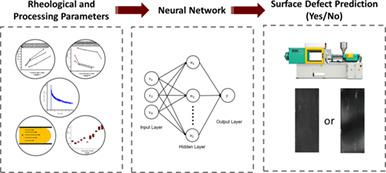当前位置:
X-MOL 学术
›
Polym. Eng. Sci.
›
论文详情
Our official English website, www.x-mol.net, welcomes your
feedback! (Note: you will need to create a separate account there.)
Neural network feature and architecture optimization for injection molding surface defect prediction of model polypropylene
Polymer Engineering and Science ( IF 3.2 ) Pub Date : 2021-08-06 , DOI: 10.1002/pen.25765 Allen Jonathan Román 1 , Shiyi Qin 2 , Victor M. Zavala 2 , Tim A. Osswald 1
Polymer Engineering and Science ( IF 3.2 ) Pub Date : 2021-08-06 , DOI: 10.1002/pen.25765 Allen Jonathan Román 1 , Shiyi Qin 2 , Victor M. Zavala 2 , Tim A. Osswald 1
Affiliation

|
The industry is heading towards digitalization with production and quality assurance of processes and products. Novel practices such as machine learning or artificial intelligence make it possible for highly complex and nonlinear occurrences to be modeled and predicted with immense accuracy when real experiences are used to train the algorithm. For example, supervised learning in a closed-loop system allows the user to analyze and predict outcomes and gives it the ability to adapt and add intelligence to the current system. This study focuses on the development of a neural network (NN) for surface defect prediction in injection molding of model polypropylene. Feature optimization allows us to conclude that rheological parameters such as the melt flow index and relaxation time ( ) can improve predictive accuracy. Furthermore, Bayesian optimization is implemented to optimize the NN structure. The optimization approach allowed for a cross-validation (CV) accuracy of 90.2% ± 4.4% with only five input parameters, while the seven-input parameter optimized structure arrived at a CV accuracy of 92.4% ± 11.4%. Although the full-feature structure optimized with Bayesian optimization concluded with slightly higher accuracy, the error range dramatically increased, meaning that this structure tends to overfit.
中文翻译:

模型聚丙烯注塑成型表面缺陷预测的神经网络特征与架构优化
该行业正在通过流程和产品的生产和质量保证走向数字化。当使用真实经验来训练算法时,机器学习或人工智能等新实践使高度复杂和非线性的事件能够以极高的精度建模和预测。例如,闭环系统中的监督学习允许用户分析和预测结果,并使其能够适应当前系统并为其添加智能。本研究的重点是开发用于模型聚丙烯注塑成型中的表面缺陷预测的神经网络 (NN)。特征优化使我们能够得出结论,熔体流动指数和弛豫时间等流变参数() 可以提高预测准确性。此外,实施贝叶斯优化以优化NN结构。优化方法允许仅使用五个输入参数的交叉验证 (CV) 精度为 90.2% ± 4.4%,而七输入参数优化结构的 CV 精度为 92.4% ± 11.4%。尽管用贝叶斯优化优化的全特征结构以略高的精度结束,但误差范围急剧增加,这意味着该结构趋于过拟合。
更新日期:2021-09-06
中文翻译:

模型聚丙烯注塑成型表面缺陷预测的神经网络特征与架构优化
该行业正在通过流程和产品的生产和质量保证走向数字化。当使用真实经验来训练算法时,机器学习或人工智能等新实践使高度复杂和非线性的事件能够以极高的精度建模和预测。例如,闭环系统中的监督学习允许用户分析和预测结果,并使其能够适应当前系统并为其添加智能。本研究的重点是开发用于模型聚丙烯注塑成型中的表面缺陷预测的神经网络 (NN)。特征优化使我们能够得出结论,熔体流动指数和弛豫时间等流变参数() 可以提高预测准确性。此外,实施贝叶斯优化以优化NN结构。优化方法允许仅使用五个输入参数的交叉验证 (CV) 精度为 90.2% ± 4.4%,而七输入参数优化结构的 CV 精度为 92.4% ± 11.4%。尽管用贝叶斯优化优化的全特征结构以略高的精度结束,但误差范围急剧增加,这意味着该结构趋于过拟合。











































 京公网安备 11010802027423号
京公网安备 11010802027423号